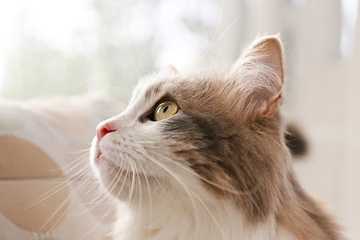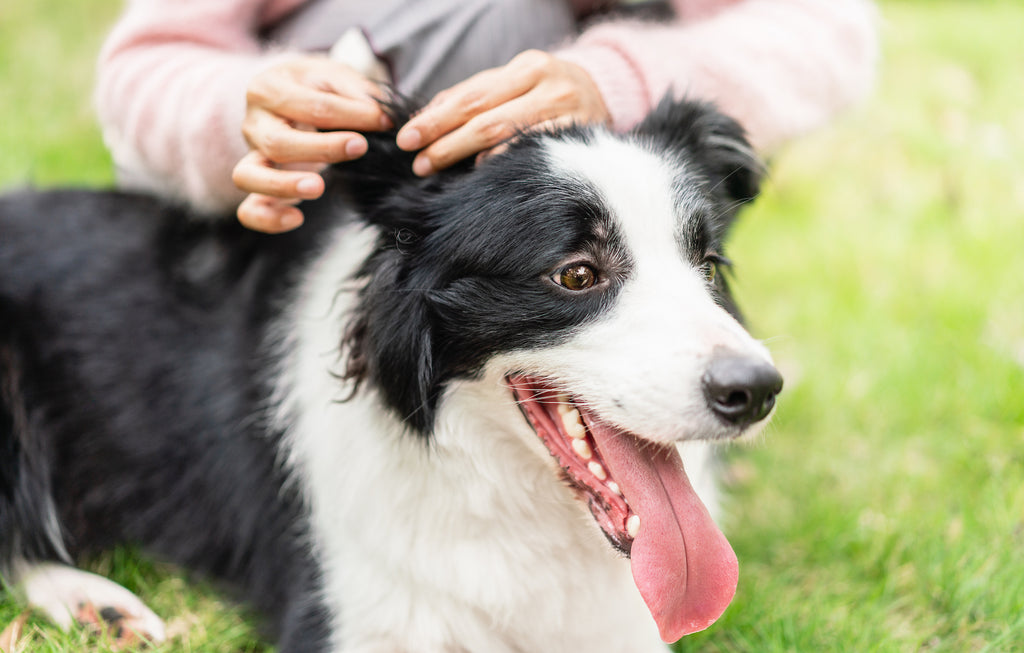9 Min Read
Henry's Pocket: A Closer Look At Your Pet's Ear Flap
Key takeaway

Why pet owners are switching to online vet care with Dutch
-
Prescriptions delivered free to you
-
Fast access to Licensed Vets over video
-
Unlimited video visits and follow-ups
If you're like most pet parents, you spend a lot of time looking at your pet and know every little detail about them. However, there's one little detail that may go unnoticed or simply overlooked — the Henry's pocket. The Henry's pocket is situated on the ear flap and is likely named so because it looks like a little pocket.
But what is Henry's pocket? Ultimately, this unique feature is also rather mysterious and can be found in both cats and dogs. So, if you've ever wondered what that small flap on the bottom of your pet's ears is, keep reading to learn more about the Henry's pocket.
- What Is A Henry's Pocket?
- The Functionality Of Henry's Pockets
- Pet Ear Anatomy
- Common Pet Ear Problems
- How To Care For Your Pet's Ears
- Henry's Pocket: FAQs
- Final Notes
What Is A Henry's Pocket?
A Henry's pocket in cats and dogs, scientifically known as the cutaneous marginal pouch, is a distinctive and somewhat mysterious feature found on many animals. Where is the Henry's pocket located? It appears as a small, vertical indentation or fold located on the inner side of the ear flap (pinna) near the base.
The Functionality Of Henry's Pockets
The exact purpose of the Henry's pocket remains a topic of speculation among veterinarians and animal biologists. Some theories suggest that it might help in enhancing the directionality of sound, allowing animals to pinpoint the location of sound better. Others believe it may serve to prevent the ear flap from resonating when an animal hears high-pitched sounds.
Regardless of its exact function, the Henry's pocket is an interesting reminder of the uniqueness of our pets.
Pet Ear Anatomy
Your pet's ears allow them to pick up the faintest sounds, whether it's the rustle of a toy or the distant sound of an approaching visitor. At a glance, cat and dog ears might seem simple, but they're actually sophisticated systems.
Cats typically have more pointed and upright ears that can swivel and rotate independently to detect sounds from various directions. On the other hand, dogs have a wider range of ear shapes, depending on the breed. Some dogs have upright ears like cats, while others have floppy or semi-erect ears.
The Henry's pocket in dogs may be more pronounced in some breeds and remains about the same in cats, although there's some variation. For instance, the Scottish Fold has an altogether different ear shape.
The basic ear anatomy remains the same for both cats and dogs, although each has evolved specific features suited to their environmental needs and behaviors.
External Ear
The pinna is the visible external part of the ear and comes in various shapes and sizes, depending on the species and breed of the animal. Its primary function is to collect and direct sound waves into the ear canal.1 The pinna is also where the Henry's pocket is located.
The external auditory canal, or ear canal, is the tube that extends from the pinna to the middle ear. It's lined with specialized skin and hair follicles, which can help trap debris and protect the ear.1
Middle Ear
The middle ear comprises the eardrum and a tiny chamber that houses three small bones.2 The tympanic member, or eardrum, separates the external ear from the middle ear. It's a thin, delicate membrane that vibrates when it receives sound waves from the external ear.2
The ossicles is a small air-filled chamber that houses three small bones – the malleus (hammer), incus (anvil), and stapes (stirrup).2 These tiny bones transmit vibrations from the eardrum to the inner ear.
Inner Ear
The inner ear includes the cochlea and the vestibular system.2 The cochlea converts vibrations into electrical signals that the brain can interpret as sound. It contains hair and sensory cells that play a crucial role in hearing.2
The vestibular system helps with balance and spatial orientation and consists of three semicircular canals and the utricle and saccule, which detect changes in head position and motion.2
The inner ear is also home to the Eustachian tube, or auditory tube. This tube connects the middle ear to the back of the throat (pharynx). It helps regulate pressure in the middle ear and drains fluids. In some animals, the Eustachian tube is shorter and less inclined than in humans, making them more prone to ear infections.
Your pet's inner ear also contains ceruminous glands that produce cerumen, commonly known as earwax. Cerumen helps trap dirt, debris, and infections while providing some protection to the ear canal.
Common Pet Ear Problems

Your pet's ears are essential for hearing. Unfortunately, they're also a common site for various health issues. From minor irritations to more severe infections, the structure of your pet's ear can sometimes become the focal point of discomfort and distress. A few common pet ear problems include the following:
- Ear infections: A common issue associated with the ear canal in pets is otitis externa, also known as an external ear infection in dogs and cats.3 Signs of an ear infection in dogs include head shaking, odor, redness of the skin, scratching, discharge, and scaly skin.3 Your dog may also show signs of pain. Unfortunately, an ear infection can happen due to various factors, including allergies, parasites, and foreign objects. Bacteria, yeasts, or a middle ear infection can also exacerbate the issue.3 Cat ear infections are also common and present the same symptoms.
- Allergies: Just like humans, pets can develop allergies to certain foods, environmental factors, or substances. Allergic reactions can cause ear canal inflammation, leading to itching, redness, and discharge.4 In most cases, identifying and avoiding the allergen will prevent symptoms in the future. Regular ear cleaning and prescribed medications can also help alleviate the symptoms.
- Ear hematomas: Ear hematomas are often a result of head shaking or scratching, which can cause the blood vessels to break.4 Treatment typically involves draining the collected blood and sometimes surgical intervention to prevent hematomas from forming in the future.4
- Frostbite: Frostbite is the freezing of tissues, and the ears are constantly exposed, making them more susceptible to extremely cold weather. Signs of frostbite include pale, cold, and hard ear tips, which can turn black and fall off.4 Treatment for minor cases involves slowly warming the affected area. However, frostbite is considered a medical emergency, so if you believe your dog has it, you should take them to the nearest emergency clinic as soon as possible.
- Hair loss: Hair loss on or around the ears can result from various factors, including allergies, mites, fungal infections, and some diseases. Some breeds are also more prone to hair loss on the ears.4
- Insect-bite dermatitis: Insect-bite dermatitis occurs when pets are bitten by insects like mosquitoes, fleas, or mites. The bite can cause an allergic reaction, leading to itching, redness, and inflammation.2 Topical treatments and insect repellents can help reduce your pet's risk.
- Mange (ear mites): Otodectic mange is one of the main causes of inflammation of the external ear canal in cats.2 The mites can cause redness, partial hair loss, itching, and general inflammation.2 Treatment options typically include medications to eliminate the mites and corticosteroids to alleviate severe itching. Unfortunately, many pet parents can't tell the difference between ear mites vs. ear wax, making them wait longer for treatment.
- Polyps: Inflammatory polyps are pinkish growths found in young cats and are commonly caused by bacterial middle ear infections.5 Signs of polyps include loss of balance, coordination, and inflammation of the outer ear.5 Typically, surgery is required to remove the polyp and its stalk to prevent regrowth.
- Earwax gland tumors: Earwax gland tumors can either be benign or malignant and occur in the external ear canal. These tumors are more likely to be malignant in older cats, but cats with a history of inflammation are more at risk of developing them.2 These tumors may obstruct the ear canal, leading to ear infections or discharge and loss of balance. Like polyps, surgical removal is often recommended.
How To Care For Your Pet's Ears

Your pet's ears are essential for hearing and an indicator of their overall health. Proper ear care is crucial to ensure they remain comfortable and free from common ear-related issues. Here are a few tips to help you care for your pet's ears:
- Regular inspection: Make it a routine to inspect your pet's ears once a week or more often if they're prone to issues like inflammation and infection. Look for signs of redness, swelling, discharge, or excessive wax. If you notice any head shaking, scratching at the ears, or signs of discomfort, it may indicate an underlying ear issue.
- Cleaning: Your vet can provide you guidance on cleaning your dog's ears, including solutions and techniques to help you avoid harming your pet's ears. You should be gentle and use cotton balls or soft clothes. While it may be tempting, avoid using Q-tips, as these can push debris further into the ear or damage the ear canal.
- Allergen management: If your pet has allergies, managing them can prevent ear issues. This might include dietary changes, medications, or environmental adjustments.
- Preventing moisture: Water in the ears can lead to infections. Always ensure your pet's ears are dry after baths or swims.
- Flea and tick control: Regularly use flea and tick preventatives like Credelio for dogs. These pests can cause ear issues and other health complications. You can also protect your pet from other pests like ear mites with products like Revolution for cats.
- Ear protection: During the cold months, consider using protective ear gear for your pet to prevent frostbite.
- Regular vet checkups: Schedule regular vet visits to ensure your pet's ears are thoroughly examined, and potential issues are detected early.
- Follow vet recommendations: Always adhere to your veterinarian's recommendations regarding ear care, medications, and treatments. Their expertise ensures your pet gets the best care possible.
Henry's Pocket: FAQs
Why is it called a Henry's pocket?
The origin of the name "Henry's pocket" remains something of a mystery. While many parts of the body are named after those who discovered them, there isn't clear documentation about who "Henry" was or why this part of the ear was named after him. The earliest known reference to the term dates back to 1971, as seen in this archive, but it doesn't provide clarity on the name's origin.
What animals have Henry's pockets?
A cutaneous marginal pouch can be found across a range of species, such as cats, dogs, bats, weasels, some primates, and potentially other mammals.

Final Notes
While the exact purpose and origin of the Henry's pocket remain shrouded in mystery, one thing is certain: the health and care of our pets' ears should never be underestimated. These complex auditory systems play a pivotal role in their overall well-being, making regular inspections, cleanings, and prompt medical interventions vital.
Even if we can't fully grasp every secret of the ear, we can still ensure that these significant organs get the care they deserve. Try Dutch today to talk to a licensed vet about your pet's ear health.Share
References
-
Moriello, Karen A. "Ear Structure and Function in Dogs." Merck Veterinary Manual, Oct. 2022, www.merckvetmanual.com/dog-owners/ear-disorders-of-dogs/ear-structure-and-function-in-dogs.
-
Bukowski, John A., and Susan Aiello. "Ear Structure and Function in Cats." Merck Veterinary Manual, Oct. 2022, www.merckvetmanual.com/cat-owners/ear-disorders-of-cats/ear-structure-and-function-in-cats.
-
Moriello, Karen A. "Ear Infections and Otitis Externa in Dogs - Dog Owners." Merck Veterinary Manual, Oct. 2022, www.merckvetmanual.com/dog-owners/ear-disorders-of-dogs/ear-infections-and-otitis-externa-in-dogs.
-
Torres, Sheila M. F. "Disorders of the Outer Ear in Dogs - Dog Owners." Merck Veterinary Manual, Oct. 2022, www.merckvetmanual.com/dog-owners/ear-disorders-of-dogs/disorders-of-the-outer-ear-in-dogs.
-
Gotthelf, Louis Norman. "Tumors of the Ear Canal in Cats ." Merck Veterinary Manual, Oct. 2022, www.merckvetmanual.com/cat-owners/ear-disorders-of-cats/tumors-of-the-ear-canal-in-cats.
